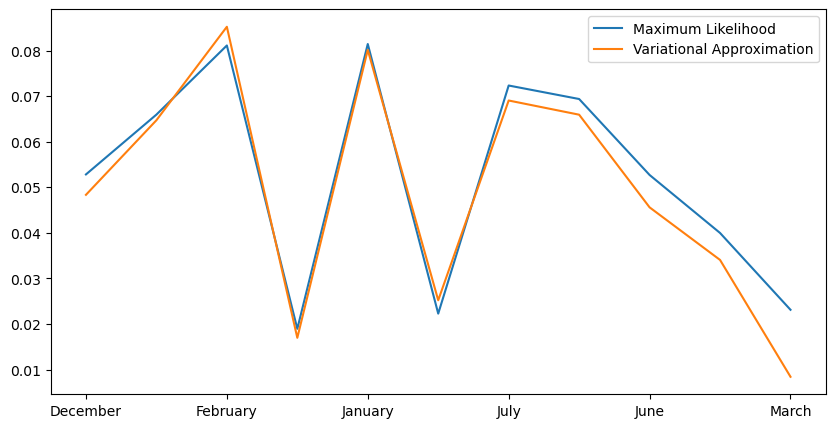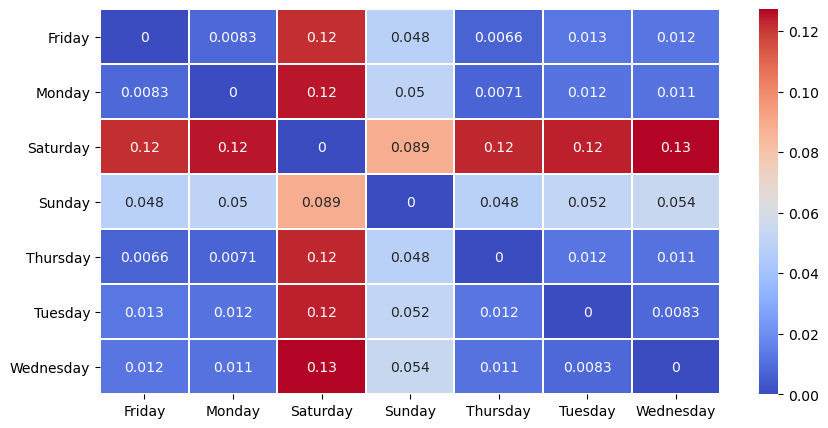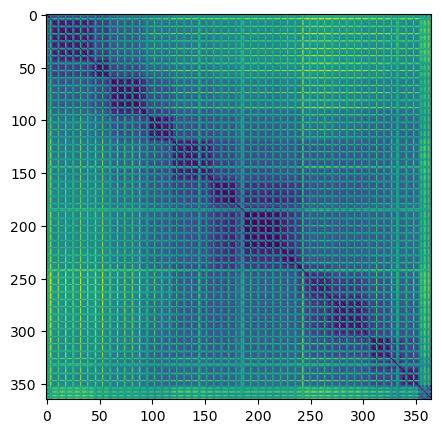Airlines Dataset: Divergence Applications
In this example, we will demonstrate change point detection and clustering on the public Airlines data set.
[1]:
import pandas
pandas.options.display.max_rows=5 # restrict to 5 rows on display
df = pandas.read_csv("https://raw.githubusercontent.com/Devvrat53/Flight-Delay-Prediction/master/Data/flight_data.csv")
df['date'] = pandas.to_datetime(df[['year', 'month', 'day']])
df['day_index'] = (df['date'] - df['date'].min()).dt.days
df['DayOfWeek'] = df['date'].dt.day_name()
df['Month'] = df['date'].dt.month_name()
df
[1]:
| year | month | day | dep_time | sched_dep_time | dep_delay | arr_time | sched_arr_time | arr_delay | carrier | ... | dest | air_time | distance | hour | minute | time_hour | date | day_index | DayOfWeek | Month | |
|---|---|---|---|---|---|---|---|---|---|---|---|---|---|---|---|---|---|---|---|---|---|
| 0 | 2013 | 1 | 1 | 517.0 | 515 | 2.0 | 830.0 | 819 | 11.0 | UA | ... | IAH | 227.0 | 1400 | 5 | 15 | 1/1/2013 5:00 | 2013-01-01 | 0 | Tuesday | January |
| 1 | 2013 | 1 | 1 | 533.0 | 529 | 4.0 | 850.0 | 830 | 20.0 | UA | ... | IAH | 227.0 | 1416 | 5 | 29 | 1/1/2013 5:00 | 2013-01-01 | 0 | Tuesday | January |
| ... | ... | ... | ... | ... | ... | ... | ... | ... | ... | ... | ... | ... | ... | ... | ... | ... | ... | ... | ... | ... | ... |
| 336774 | 2013 | 9 | 30 | NaN | 1159 | NaN | NaN | 1344 | NaN | MQ | ... | CLE | NaN | 419 | 11 | 59 | 30-09-2013 11:00 | 2013-09-30 | 272 | Monday | September |
| 336775 | 2013 | 9 | 30 | NaN | 840 | NaN | NaN | 1020 | NaN | MQ | ... | RDU | NaN | 431 | 8 | 40 | 30-09-2013 08:00 | 2013-09-30 | 272 | Monday | September |
336776 rows × 23 columns
Destination Airport
Let’s just look at how the dest feature changes from month to month. In this example, we will use total variation. Since dest is a categorical variable, it is natural to use a density estimator based approach to calculating statistical divergences such as total variation. We use the calc_tv_mle function for this, which computes maximum likelihood based density estimators using histograms, and subsequently feeds this into the formula for total
variation.
[2]:
import numpy
from mvtk.supervisor.divergence import calc_tv_mle
covariate = ['dest']
max_likelihood_drift_series = []
def encode(v, d={}):
if not v in d:
d[v] = len(d)
return d[v]
grouped = df.groupby('Month')
batches = [g[1][covariate].values.reshape(-1, 1) for g in grouped]
max_likelihood_drift_series = []
for (month, _), new_batch, old_batch in zip(grouped, batches[1:], batches[:-1]):
max_likelihood_drift_series.append(calc_tv_mle([old_batch], [new_batch]))
Welcome to
____ __
/ __/__ ___ _____/ /__
_\ \/ _ \/ _ `/ __/ '_/
/__ / .__/\_,_/_/ /_/\_\ version 3.1.2
/_/
Using Python version 3.8.11 (default, Aug 6 2021 08:56:27)
Spark context Web UI available at http://c02yn2epjg5j.corp.root.nasd.com:4040
Spark context available as 'sc' (master = local[*], app id = local-1630586243406).
SparkSession available as 'spark'.
WARNING:absl:No GPU/TPU found, falling back to CPU. (Set TF_CPP_MIN_LOG_LEVEL=0 and rerun for more info.)
[3]:
df[covariate].nunique()
[3]:
dest 105
dtype: int64
Density vs Variational
Now let’s compare these results to those produced by variational estimators. Variational estimation of statistical divergences is an elegant approach well suited for high dimensional floating point data. However, categorical data needs to be one hot encoded to be made compatible with the variational approach. Since dest has 105 unique values, this requires turning a one dimensional dataset into a 105 dimensional one. We can increase the batch size and number of epochs to try to compensate
for this. As we shall see, this makes the problem complex enough that the variational estimates do not agree well with the histogram based ones.
[4]:
from sklearn.preprocessing import OneHotEncoder
from mvtk.supervisor.divergence import calc_tv
covariate = ['dest']
encoder = OneHotEncoder(sparse=False)
encoder.fit(df[covariate].values)
variational_drift_series = []
previous_ohc = None
months = []
for i, (month, group1) in enumerate(df.groupby('Month')):
ohc = [encoder.transform(group1[covariate])]
if previous_ohc is not None:
variational_drift_series.append(calc_tv(ohc, previous_ohc, num_epochs=16, num_batches=32, batch_size=512))
months.append(month)
previous_ohc = ohc
[5]:
import matplotlib.pylab as plt
from matplotlib.ticker import MaxNLocator
plt.rcParams['figure.figsize'] = [10, 5]
fig, ax = plt.subplots()
plt.plot(max_likelihood_drift_series, label='Maximum Likelihood')
plt.plot(variational_drift_series, label='Variational Approximation')
ax.xaxis.set_major_formatter(lambda x_val, x_pos: months[int(x_pos)])
ax.xaxis.set_major_locator(MaxNLocator(integer=True))
plt.legend()
plt.show()

Generally, the variational estimator degrades in accuracy for categorical data with large numbers of categories. However, it works quite well for this example after increasing the batch size and number of epochs for more accurate estimates.
[6]:
numpy.corrcoef(variational_drift_series, max_likelihood_drift_series)[1, 0]
[6]:
0.9831698719629802
Clustering
Now let’s construct a distance matrix between data aggregated by each day of the week and cluster it.
[7]:
import matplotlib.pyplot as plt
import seaborn as sns
import itertools
import numpy
from mvtk.supervisor.divergence import calc_tv_mle
from mvtk.supervisor.divergence import get_distance_matrix
from mvtk.supervisor.utils import parallel
from mvtk.supervisor.utils import compute_divergence_crosstabs
feature_names = ['origin', 'dest']
features = df[feature_names + ['DayOfWeek']]
distance_matrix = compute_divergence_crosstabs(features,
'DayOfWeek',
divergence=calc_tv_mle)
sns.heatmap(distance_matrix, cmap='coolwarm', linewidths=0.30, annot=True)
plt.show()

As we might expect, it seems Saturday, and to a lesser extent Sunday, are somewhat different from the other days of the week.
[8]:
from sklearn.cluster import AgglomerativeClustering
def agglomerative_clustering(distance_matrix, n_clusters, affinity='precomputed', linkage='complete', **kwargs):
return AgglomerativeClustering(n_clusters=n_clusters, **kwargs).fit_predict(distance_matrix)
print('Two clusters', agglomerative_clustering(distance_matrix, n_clusters=2, linkage='complete'))
print('Three clusters', agglomerative_clustering(distance_matrix, n_clusters=3, linkage='complete'))
Two clusters [0 0 1 0 0 0 0]
Three clusters [0 0 1 2 0 0 0]
/opt/anaconda3/lib/python3.8/site-packages/scipy/cluster/hierarchy.py:834: ClusterWarning: scipy.cluster: The symmetric non-negative hollow observation matrix looks suspiciously like an uncondensed distance matrix
return linkage(y, method='ward', metric='euclidean')
/opt/anaconda3/lib/python3.8/site-packages/scipy/cluster/hierarchy.py:834: ClusterWarning: scipy.cluster: The symmetric non-negative hollow observation matrix looks suspiciously like an uncondensed distance matrix
return linkage(y, method='ward', metric='euclidean')
More data
[9]:
import os
import pandas
df = df[['origin', 'dest', 'day_index']]
[10]:
import itertools
import numpy
from mvtk.supervisor.divergence import calc_tv_mle
df.sort_values('day_index', inplace=True)
features = df[feature_names + ['day_index']]
distance_matrix = compute_divergence_crosstabs(features, 'day_index', divergence=calc_tv_mle)
/opt/anaconda3/lib/python3.8/site-packages/pandas/util/_decorators.py:311: SettingWithCopyWarning:
A value is trying to be set on a copy of a slice from a DataFrame
See the caveats in the documentation: https://pandas.pydata.org/pandas-docs/stable/user_guide/indexing.html#returning-a-view-versus-a-copy
return func(*args, **kwargs)
[11]:
import matplotlib.pyplot as plt
plt.imshow(distance_matrix)
plt.show()
